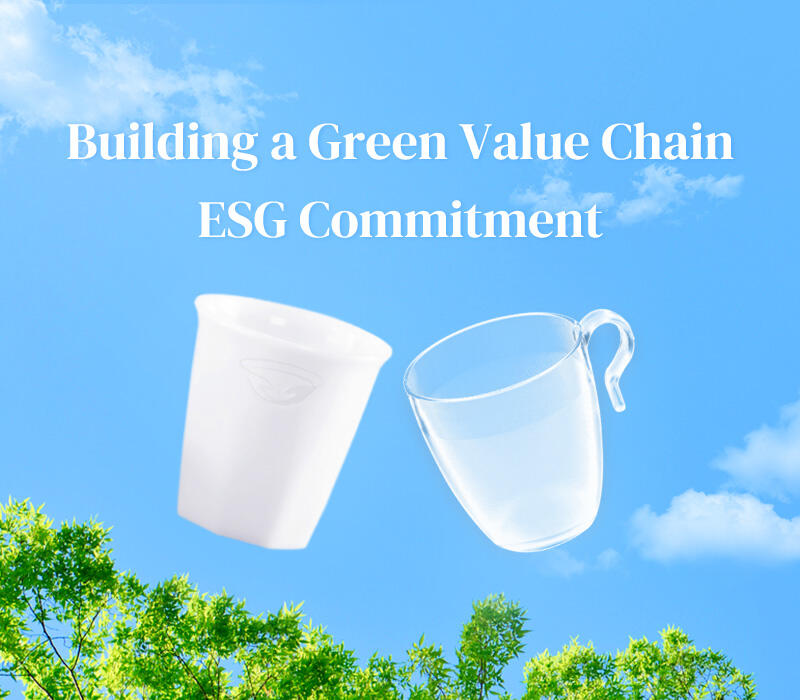Sustainability
- Home
- Sustainability
- CPET (Crystallized PET)
CPET (Crystallized PET)
Guide to Crystallized PET (CPET) Reusable Plastic Tableware
Are you considering finding a reusable alternative to traditional plastic tableware? For a long time, plastic tableware has raised worries regarding health and the environment. Nonetheless, advances in the manufacturing process have promoted reusable Crystallized PET (CPET) plastic tableware. In this guide, Living Forward, a leading CPET tableware manufacturer in Taiwan, aims to give you a thorough understanding of CPET tableware, outlining its characteristics and advantages.
What is CPET Tableware?
CPET, or Crystallized Polyethylene Terephthalate, is a type of plastic material. Due to its sturdiness and heat-resistant properties, it is commonly used in the production of food containers, including reusable tableware. CPET is not a newly developed material; it is made from pure PET material. Manufacturers have used nucleating agents for production and molding, while Living Forward uses a crystallization process instead. Each company employs different manufacturing techniques.
PET is a safe food-grade plastic commonly found in our daily lives, such as PET bottles. CPET, on the other hand, undergoes a unique physical crystallization process. This preserves PET's advantages, such as durability, lightweight, and recyclability. After crystallization, CPET's molecular architecture forms a tighter structure, enabling it to resist high temperatures.
Tested by SGS at 140°C (284℉), CPET shows no signs of deformation or softening. Importantly, it is free from harmful substances such as plasticizers, melamine, formaldehyde, Bisphenol A (BPA-Free), and environmental hormones. It is perfect for microwaving. The tableware can also be safely cleaned and sterilized in a dishwasher at high temperatures. Furthermore, SGS has certified it as safe and non-toxic according to the standards set by the U.S. FDA.
CPET reusable plastic tableware exhibits excellent heat insulation, acid and alkali resistance, impact resistance, and durability. It has a porcelain-like texture, breaking away from the cheap and tacky impression often associated with plastic products and offering elegance. According to International Universal Recycling Codes, PET has the digit 1 (♳) as its resin identification code (RIC), and so does CPET. CPET reusable tableware is 100% recyclable and reusable, an eco-friendly and sustainable product contributing to the 'circular economy.'
The Manufacturing Process of CPET Tableware
The production process of CPET tableware involves a proprietary method using infrared crystallization, similar to a kiln firing process. Living Forward has developed breakthrough manufacturing techniques for CPET mass production, which are currently pending patent approval.
Advantages of CPET Tableware: Why Choose CPET?
Durability:
It is resistant to acids, alkalis, and impacts. Its sturdiness makes it suitable for home and commercial environments, such as restaurants and catering services.
Heat Resistance and Microwave-safe:
It can resist high temperatures and is microwave-safe.
Safety and Non-Toxicity:
CPET is safe from harmful substances so that you can use it confidently. It's also compliant with food safety standards. It is an excellent choice for both home and business use.
Lightweight:
It has lightweight features and ease of handling. It is an excellent choice for outdoor events and large gatherings.
Recyclable and Reusable:
CPET tableware is recyclable and can be reused multiple times, promoting environmental sustainability.
Aesthetically Pleasing:
CPET reusable plastic tableware is known for its high-quality finish and porcelain-like texture, which enhance the dining experience. Thus, it is a beautiful and delightful choice for any dining occasion.
FAQ about CPET Tableware
1. Does CPET contain plasticizers?
No, not all plastic products contain plasticizers. PET itself does not contain plasticizers, so CPET (Crystallized PET) is free from plasticizers and cannot have them added. Adding plasticizers would hinder the molding process.
2. What is the heat resistance of CPET tableware?
PET undergoes a crystallization process to become CPET (Crystallized PET), giving CPET an opaque (white) appearance and high-temperature resistance. It can withstand temperatures up to 140℃ and low temperatures to -20℃.
3. Why is CPET tableware considered non-toxic tableware?
CPET tableware is manufactured from pure PET material, and PET material does not contain any toxicity. Therefore, CPET tableware is considered non-toxic tableware.
4. Does CPET tableware meet food safety regulations?
Yes. CPET tableware has been tested by SGS with zero detection, complying with the Ministry of Health and Welfare of the Republic of China's [Sanitation standard for food utensils, containers, and packages]. Additionally, it has been tested according to the standards of the U.S. FDA and certified as safe and non-toxic.
5. Can CPET tableware be used for microwave heating?
Yes, CPET tableware is microwave-safe. It is recommended to limit the microwave heating time to approximately 2 minutes (for microwaves with a power of 900W or lower). However, it is still advisable to follow the specific instructions provided by each brand to ensure safety.
6. Can CPET tableware be cleaned in a dishwasher?
Yes, CPET tableware is dishwasher-safe. The dishwasher washing temperature is typically around 40-80°C, and CPET tableware is resistant to high temperatures and non-toxic, ensuring safety.
7. Can CPET tableware be sterilized with steam or UV light?
Yes. Using a steam sterilizer or placing it in an ultraviolet sterilizer is acceptable.
8. Does CPET tableware stain easily?
Not at all. CPET tableware has smaller pores, making it easy to clean, and immediate cleaning after use reduces the likelihood of staining. It is advisable to rinse it promptly after using food items containing high levels of pigments, such as coffee, chili sauce, ketchup, mustard, etc., to prevent staining.
9. How long is the service life of CPET tableware?
The service life of CPET tableware is approximately 3 to 5 years.
10. Is CPET tableware fragile?
No. CPET tableware has excellent impact resistance, ensuring better safety than fragile materials like ceramics and glass.
11. Is it normal for CPET tableware to become rough after some use?
The smooth surface of CPET tableware is a natural result of PET crystallization. Prolonged scrubbing and friction may gradually diminish the smooth effect, but it still maintains its non-toxic properties, so there's no need to worry.
12. Why is CPET tableware considered an environmentally friendly product?
CPET falls under resin identification code (RIC) digit 1, which means it is reusable and 100% recyclable, making it an environmentally friendly product.
Looking For a Professional CPET Reusable Plastic Tableware Manufacturer?
Taken together, CPET reusable plastic tableware offers a compelling alternative to traditional plastic tableware, addressing concerns about durability, safety, and environmental impact. We encourage you to consider CPET for your dining needs. By updating and expanding our understanding of CPET tableware, we can make choices that benefit ourselves and the environment.
Living Forward, located in Taiwan, is a professional CPET tableware manufacturer. Our skilled R&D team leverages mold flow analysis, Pro E, 3D printers, and other cutting-edge hardware and software equipment. We offer comprehensive OEM/ODM/OBM services, distribution channel and private label (customer brand) related services, and customized logo printing services. Our sustainable, reusable plastic tableware and utensils are manufactured and packaged in a controlled cleanroom environment. If you have further inquiries or would like to explore our CPET product range, don't hesitate to contact us.



